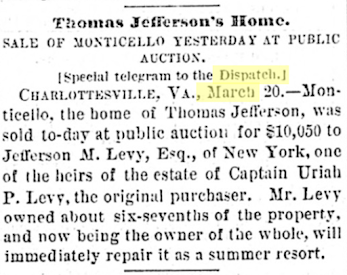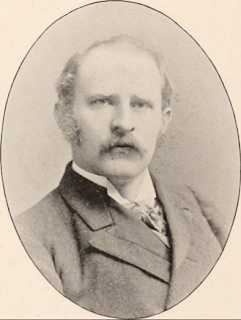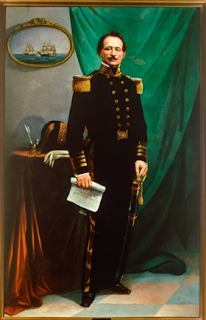October 2024
Saving Monticello: The Newsletter
The latest about the book, author events, and more
NewsletterEditor - Marc Leepson

Volume XXI, Number 10 October2024
[image error]
A SUMMER RESORT: The story of how JeffersonMonroe Levy gained control of Monticello in 1879 after more than two decades oflegal wrangling among himself and his Uncle Uriah Levy’s other heirs is a longand winding one. And one with a surprising conclusion.It began shortly after Uriah Levy’s death on March 22, 1862,when his heirs—more than 60 of them—discovered that the Commodore unexpectedly bequeathedMonticello to the people of the United States to be used as an agriculturalschool for the orphans of Navy warrant officers.

That didn’t happen because Congress,which would have had to approve the idea, had little time to deal with a realestate matter during the darkest days of the Civil War.
The will stipulated that if Congress did not green lightthat plan, Monticello should go to the state of Virginia for the same purpose. Virginia,by then no longer in the Union, took no action—even though the South had confiscatedMonticello in 1861 since it was owned by a northerner.
The will had a third contingency; if Virginia said no, thenJefferson’s Charlottesville property would go to the Portuguese Hebrewcongregations of New York, Philadelphia, and Richmond to be used as anagricultural school for orphans, both Jewish and non.
With no action on the synagogue front, family members in 1868filed partition lawsuits in Virginia and New York (where UPL lived most of the time)—thekind often used in contested divorce proceedings—to try to clear up Monticello’sfate. That year, courts in Richmond and New York ruled that Levy’s stipulationthat Monticello would become a school for orphans was invalid. The courts then orderedthat Monticello should be auctioned on the premises. The proceeds would then bedivided among Uriah Levy’s many heirs, who were allocated shares in the ownershipof the property.
At the time of the court decision, Jefferson Monroe Levywas sixteen-and-a-half years old.
Whatfollowed was more than a decade of more legal wrangling over Monticello’s fate.Things were not settled, as I noted in Saving Monticello, until 1879. Andit wasn’t a court ruling that did it.
Jefferson Monroe Levy had in the intervening years made a fortuneas a big-time real estate and stock speculator. And he decided to take the fateof Monticello into his own hands beginning in the mid-1870s, and started buyingout other family members’ inheritance shares.
In June 1875, Jefferson Levy he bought the Monticelloinheritance shares of Virginia Lopez Levy Ree—Uriah Levy’s remarried widow—alongwith those of her husband, William J. Ree. In March 1876. JML purchased his parents,Fanny Jonas Phillips Levy’s Monticello shares.
Then, in October 1876. Levy bought the shares of VirginiaRee’s brother George Washington Lopez of Spanish Town, Jamaica. By April the following year, Jefferson Levy (below) hadaccumulated about half of Monticello’s shares.

It is not a matter of recordexactly how much Jefferson Levy paid the other heirs for their shares. The bestguess is that it was approximately $10,000—a not insignificant sum in the late1870s.
On February 5, 1879, Levyfamily lawyer George Carr, an executor of Uriah Levy’s estate, placed an ad in aCharlottesville newspaper. Itannounced that Monticello and its surrounding acreage would be offered forsale “at public auction, to the highest bidder on the premises between 11 o’clockA.M., and 2 o’clock P.M., on Thursday, March 20th.”
It appears that JeffersonMonroe Levy, a month shy of his 27th birthday, was the only bidderat the March 20 auction. His winning bid was $10,050. That money was distributedto the other heirs.
But since Levy had bought outlarge portions from some of the other heirs, he received a good percentage ofthe purchase price. Jefferson Levy, in other words, had more or less boughtMonticello from himself.
 CORRECTION: In last month’s newsletter I mentioned in passing that a full-lengthportrait of Uriah Levy in his Navy uniform (below) that had hung inMonticello was on display at the U.S. Naval Academy’s Museum in Annapolis. JeffersonMonroe Levy’s sister Amelia Mayhoff, who inherited the painting after his deathin 1924, had donated the portrait to the Naval Academy in 1928. She did soafter the Thomas Jefferson Foundation, which bought the house from Levy in 1923, turneddown her offer to keep it on kept on display in the house.
CORRECTION: In last month’s newsletter I mentioned in passing that a full-lengthportrait of Uriah Levy in his Navy uniform (below) that had hung inMonticello was on display at the U.S. Naval Academy’s Museum in Annapolis. JeffersonMonroe Levy’s sister Amelia Mayhoff, who inherited the painting after his deathin 1924, had donated the portrait to the Naval Academy in 1928. She did soafter the Thomas Jefferson Foundation, which bought the house from Levy in 1923, turneddown her offer to keep it on kept on display in the house.
EVENTS: Two scheduled for this month:
On Wednesday, October 16, I’ll bedoing a talk on Saving Monticello for the McLean (Virginia) Newcomersand Neighbors Club.
On Sunday, October 20, I have talkand book signing at the Thomas Balch Library in Leesburg, Virginia, on my secondhouse history book, Huntland. It begins at 2:00 in the afternoon, and isfree and open to the public. Registration is required, though. To doo so, call 703-737-7195, email balchlib@leesburgva.gov or go to https://tinyurl.com/TBLEvents
I will be doing more events in the fall andwinter, and in 2025, including talks on Saving Monticello. I also willbe doing talks and media interviews starting in early December for my new book,The Unlikely War Hero, a slice-of-life biography of the extraordinary VietnamWar story of Doug Hegdahl, the youngest and lowest ranking American prisonerheld in Hanoi during the war. More info on that book at https://bit.ly/Hegdahl
If you’d like to arrange a talk on thatbook, on Saving Monticello, or any of my other books, feel free to emailme at marcleepson@gmail.com
For details on upcoming events, check theEvents page on my website: marcleepson.com/events

COMMERCE: Ihave brand-new paperback copies of SavingMonticello and a few as-new hardcovers. To order personalized, autographedcopies, go to https://bit.ly/BookOrdering or email me directly at marcleepson@gmail.com
I also havea stack of six of my other books: Flag:An American Biography; Desperate Engagement; What So Proudly We Hailed; and Ballad of the Green Beret, and Huntland.
You canread back issues of this newsletter at http://bit.ly/SMOnline



